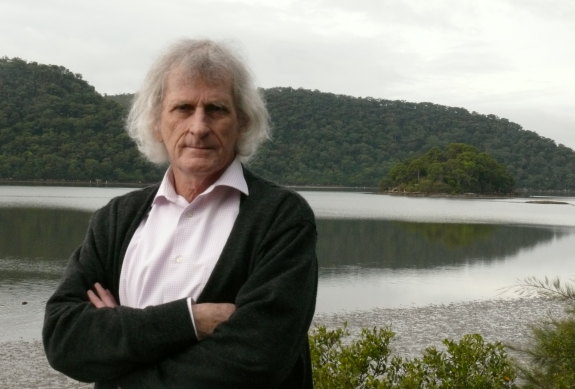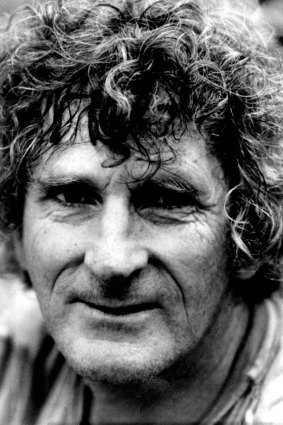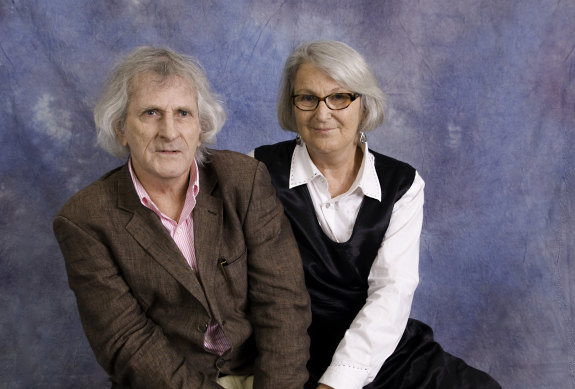This was published 1 year ago
The last interview: Robert Adamson on poetry, life and facing death
The last weeks of poet Robert Adamson’s life flowed with conversation at the house above the Hawkesbury River where he lived with his wife, photographer Juno Gemes, and their cats and rescued bowerbird. When Adamson, aged 79, was diagnosed with terminal liver cancer, he and Gemes decided to spread the news widely.
“I didn’t want to tell anyone. I was just going to carry on,” Adamson said soon after Gemes posted on social media in early November. But she remembered “an avalanche of beautiful things” that were said about poet Martin Harrison after his sudden death in 2014. “I loved Martin and I thought, why didn’t he get to hear this?”
Encouraged by her friend, Petrea King, an adviser on end-of-life matters, Gemes said “it seemed to me like a generous thing to do, because you didn’t know what you were going to get back. But I kind of had a feeling.”
A flood of messages began, turning Gemes’ phone into a “love bomb” and leading to a stream of visitors who had been touched by Adamson’s 50-year career as a celebrated poet, editor, publisher, teacher, mentor and friend. First to arrive were Luke Davies, Mark Mordue and Judith Crispin, younger poets grateful for Adamson’s support. Old friends from the circles of books, arts and activism came, such as Morry and Anna Schwartz, Garry and Rose Shead, Wendy Whiteley, Linda Burney, Robyn Ravlich, Anne Summers and Tracey Moffatt.

Robert Adamson by his beloved Hawkesbury RiverCredit: Juno Gemes
Minister for the Arts Tony Burke made a phone call. Neighbours came, a filmmaker, and Bruce Williams from 2SER to record Adamson reviewing The Philosophy of Modern Song by Bob Dylan. Poet Judith Beveridge spoke for many in an email thanking Adamson for “exquisite poetry”, for giving the Hawkesbury a place in the national consciousness, and for being “a poetic-father to so many poets”.
She wrote: “I often turn to your work for inspiration and to remember why I love poetry so much and how important craft and technique are as you have always been the most exemplary of teachers – the tone, the linguistic virtuosity, the use of the line and the flow of the words, the insights, the wit and of course the ever-present celebration and evocation of birds are truly masterful and suggestive of a mind, heart and spirit alive to and attentive of this wonderful world in which we find ourselves.”

Adamson in the early 1990s around the time he published Waving to Hart Crane.Credit: Juno Gemes
My husband and I were invited to lunch on the deck in November when Adamson was still energised by company, and I recorded what we all agreed might be his last interview. Six hours of stories and laughter ran by like the river below us, where his retired fishing boat rocked among the mangroves.
As always, we were entranced by the intimacy between Adamson and Spinoza, the indigo bowerbird he found as a fuzzy chick knocked out of its nest and gently rehabilitated for seven years. Spin was restorative company for Adamson when he had treatment for hepatitis C six years ago and recovered to write poems such as Spinoza, which addresses the bird as “my soul’s friend”.
Spin sang and danced, mimicked passing motorboats, conversed with the poet in identical flat-vowelled voices. “Yeah,” they agreed. A daily visitor was Johnny Griffiths, local cafe owner and river friend for 50 years since Adamson taught him to fish and turned his school class on to T.S. Eliot. Now Griffiths was taking over Spin’s care.
In his study, Adamson talked calmly about dying. As a young man, despite his risky ways, he wanted to reach the age of 99 like his grandfather.
“But since this news that I’ve got four months to live, I just said, that’s interesting. I can have a great four months. I can get my last book finished and be with Spin and Juno and on the river. I was more worried about Juno than dying.
“I have no one to blame. If this cancer came from the time I was drinking too much, that’s what happens. If it came from when I was taking drugs, or if I just wore myself out, it’s no one’s fault. The doctors did their best. It’s God and nature – that fits in with Spinoza.”
He named the bird after the 17th-century philosopher Spinoza, who opposed human arrogance that puts us at the centre of the universe. “He doesn’t think God is one deity or one person, he thinks that we all are God, the universe is God, birds and fishes are God. Spinoza is God.”
Adamson learnt to recite Tennyson and Shelley as a dyslexic child in a family of fishermen. He wrote poems in his head in Long Bay jail after a string of youthful crimes, the most prophetic stealing a rifle bird from Taronga Zoo. Despite leaving school at 14, his passion led him to edit a poetry magazine, run a small press with Gemes, become chair of Australian poetry at UTS, publish 16 books of poems and an autobiography, Inside Out.
Settled with Gemes on his grandfather’s river since the ’80s, he finally kicked his addictions, as he wrote in The Kingfisher’s Soul: “I preferred the cover of night, yet here, I stepped / into the day by following your gaze.”

Robert Adamson and Juno Gemes in 2009. When news of his illness broke, her phone was turned into a “love bomb”.Credit: Juno Gemes
“A couple of times I nearly died. I was always worried about things I hadn’t done. But now I can see even if I lived another 20 years, there’s not a huge lot more.” Quickly he added that he would have written and painted more, set up another literary magazine for past students to edit, and run “a once-a-month poetry school here in the house with selected students, 10 of the best poets, a poetry workshop that went on and on”.
Opening a book on the Dutch artist Piet Mondrian, Adamson showed how his paintings of trees evolved into geometric abstraction. Mondrian’s “search for order” influenced him – “he kept refining it and making it purer and clearer. That’s what I tried to do in my poetry, hone it back and back and back, just the essence.”
Devin Johnston, his American publisher, edited the most recent volume of selected poems in 2020, Reaching Light, tracing the evolution of the “restless poet”. At my request, Adamson read a few “good ones”: Swimming Out with Emmylou Harris, Meaning, Windy Drop Down Creek, On Not Seeing Paul Cezanne and Love Songs for Juno, which began as an apology scribbled on beer coasters. “Juno’s woven through all these,” he said. “She’s a hard critic and she’s so unbelievably kind at the same time.”
As her husband weakened, Gemes asked Johnston to bring forward a planned trip from Chicago to edit his final book. Years of research and journal notes had not been shaped into the full story of his bond with the bowerbird. Johnston combined the Spinoza material with essays written for Fishing World magazine to create an episodic narrative, Birds and Fish, to be published by Morry Schwartz at Black Inc.
“There’s a lifelong sense with both birds and fish of a deep and loving ambivalence – about killing fish to see them and connect with them, and caging birds but feeling so connected with them. An undercurrent of captivity and freedom runs through it,” Johnston said.
In the first two weeks of December, he sat beside the hospital bed in Adamson’s study and read the manuscript to him, offering suggestions and taking in his wishes. They were still working when Adamson was moved to a hospice, until the day before he slipped away on December 16, sooner than he’d hoped but with everything important done.
There will be a celebration of Adamson’s life at 1pm on January 13 at the Peat Island Chapel at Mooney Mooney, with poetry, music and an honour guard of oyster farmers.
The Booklist is a weekly newsletter for book lovers from books editor Jason Steger. Get it delivered every Friday.